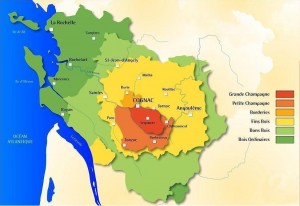The crus are the wine growing areas in the cognac region. They are all by law in detail defined. There are six of them: Grande Champagne, Petite Champagne, Borderies, Fins Bois, Bons Bois and Bois Ordinaires (sometimes called bois communs or bois à terroirs).
A bottle of cognac does not have to be from one Cru. Many firms make blends from different crus. They buy wine and eaux-de-vie from winegrowers from different districts and store them to let them age. Ageing of the cognacs is a metier that takes place under the management of a Maître de Chai or cellar master (sometimes called: master blender). It is the maître de chai who determines the different crus and different years that are to be used for making a specific blend that will match the flavour characteristics of the house.
The smaller producers who make cognac from the grapes of their own vineyards usually make them from just one cru. These producers are called bouilleurs de cru. But the great firms sometimes also make cognacs from just one cru. These cognacs receive the appellation controlee of that cru. If it says on a label ‘appellation contrôlé’ along with the mentioning of a cru, then it is guaranteed that only cognac of that cru is inside the bottle.
Note: appellation bois ordinaires contrôlé does not exist.
Update 2021: this has been changed for several years. In any case, before 2009. Appellation Bois Ordinaires Controlée or Appellation Bois à Terroir Controlée.
A special appellation is the ‘fine champagne’. A cognac that is a fine champagne has to be for 51% or more Grande Champagne and the rest Petite Champagne. But be ware. The word ‘fine’ may also be used in combination with other crus to indicate that the cognac is 100% of that cru. So Fins Bois is essentially the same as Fine Fins Bois because also without the addition of the word Fine, the cognac has to be 100% Fins Bois when the label says: ‘appellation fins bois controlé’.
To summarise :
Grande fine champagne = grande champagne
Petite fine champagne = petite champagne
Fine champagne = blend of grande champagne and petite champagne (minimum 50% grande champagne).
Fine Borderies = Borderies
Fine fins bois = fins bois.
Fine bons bois = bons bois
Bois ordinaires has no ‘appellation’, therefore there is no fine bois ordinaires).

